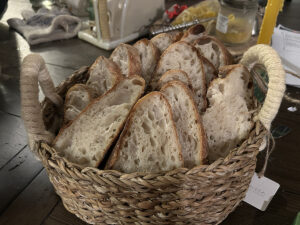One night last week, I found the cat staring intently at my little basket of kitchen laundry by the stove. Usually this posture means she hears a mouse somewhere, so I sent my husband to investigate. (Yes, I’m a wimp.) He came back chuckling, with a curled-up woolly worm in his hand. I breathed a sigh of relief.
Then I started to wonder—what exactly are these things, and how are they getting in my house? This was at least the third woolly worm to invade my kitchen in recent weeks. Time to do a little detective work.
I found out that the woolly worm, or woolly bear, is the larval stage of the Isabella Tiger Moth, a small, yellowish moth that feeds on a variety of plants. There are two generations of woolly worms each year; the second  generation is the one we’re seeing now.
generation is the one we’re seeing now.
Folklore has it that the 13 segments of the woolly worm’s body correlate to the 13 weeks of winter. The wider the brown stripe in the middle, the milder the winter. The one I found today had a wide brown stripe, so perhaps we’ll be in for a mild winter. Research doesn’t seem to bear out this correlation, but really, why let a little thing like that get in the way of a perfectly good weather prognostication?
The woolly worms you see crawling about these last warm days of autumn are probably looking for a safe, sheltered place to hide for the winter. Once settled in their snug hideaways, they hibernate, creating their own natural antifreeze to prevent their cells from completely freezing when the temperature drops.
Another autumn invader I saw flying about this week is the multicolored Asian lady beetle, which closely resembles our native ladybug but has the irritating habit of moving indoors for the winter along with a few hundred of its closest friends. On a sunny day in late fall, we’ll find Asian lady beetles plastered all over the south side of our white house, searching for entrance. This being an old, drafty farmhouse, some of them inevitably find their way in.
Asian lady beetles aren’t harmful in any way—they’re actually beneficial in the garden. They do, however, emit a nasty odor and yellow liquid from their knee joints when they’re upset, and they occasionally bite.
Asian lady beetles are an introduced species from Asia with few natural predators here in the United States. Although they were intentionally imported and released as early as 1916 in an effort to control pests, it is thought that our current infestation may have originated on a freighter that docked in New Orleans.
Another invader with a penchant for indoor living is the boxelder bug, a colorful red and black insect with long legs and antennae. Like the ladybeetles, boxelder bugs are annoying but harmless–unless you happen to be a female boxelder tree. They stink if crushed, so don’t try swatting them. In late fall, the bugs often congregate on the siding of a building before moving indoors. In the spring, they move back out to lay their eggs.
Since none of these autumn invaders is armed or dangerous, you don’t need any toxic chemicals to get rid of them. Simply vacuum them up and dispose of them. Or, for hours of cheap entertainment, try Lehman’s Arm’s Length Spider Catcher. Who needs a Wii if you’ve got one of these?!
After all this detective work, I still didn’t solve the mystery of how the woolly worms are getting indoors. My best guess is that they’re hitching a ride on our boots or the dog’s tail. If anyone has a better explanation, please let me know!






























